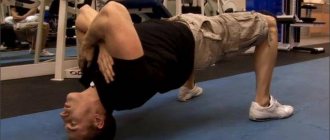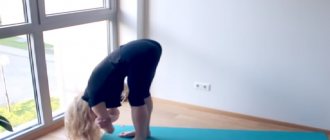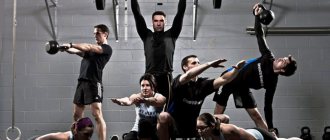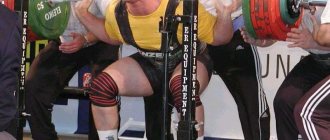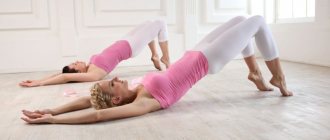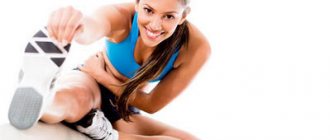Why do you need to warm up for a run?
A pre-run warm-up for beginners is designed to help the runner warm up their muscles and prepare their joints as they experience something akin to an impact every time the foot hits the ground. This is a specific running load, but with proper preparation it is not dangerous for the spine and leg joints that take the shock impulse.
Why is it so important to pay attention to joint preparation:
- Muscles and joints interact thanks to ligaments. The prepared muscles smoothly pull the ligaments and, as a result, the joints do not rub against each other. The absence of friction prolongs the youth of the joints.
- The joints are filled with fluid from the inside. When there is no physical activity, this fluid becomes thicker. Running on a cold joint provokes pain and also does not allow the fluid to perform its functions - to protect and lubricate the joint.
- Warming up improves blood flow to muscles and joints. This helps them adapt to the load and increases the effectiveness of the workout.
Did you know? Warm-up is useful not only for the musculoskeletal system, but also for other systems of the human body. A set of preparatory exercises will help to smoothly speed up the heart's work compared to the resting state.
Why do you need to stretch after running?
Should you stretch your muscles after running? Stretching at the end of your run is a must! Why is it necessary?
- When muscles are under heavy load, microtraumas form in them. This is not bad, on the contrary, muscle tissue increases and becomes stronger. But this is why the day after training your body hurts . This kind of pain is called sore throat. If you don't stretch, it can be unbearable. And well-done exercises reduce this pain well.
- Stretching is a must for girls who are afraid to “pump up” the large, ugly muscles in the front of the thigh. In most cases this is impossible, and fears are in vain . But some young ladies really have a predisposition to rapid and noticeable muscle growth. And stretching at the end of a run helps neutralize this effect, making the muscles flatter and the contours of the hips and legs more feminine.
- When running, the muscles, especially in the lower torso, are very tense. They need to be relaxed . Stretching is excellent for this purpose.
- During active physical activity, the body is in an excited state - breathing quickens, energy splashes out. Stretching is necessary to calm the body. It puts you in a relaxed and calm state and has a positive effect on your emotional state.
Thus, stretching the muscles after running is necessary to relax them, prevent severe soreness and calm the body at the end of the workout.
This is interesting
- [uaf_vkcount url='href=»https://beginogi.ru/kak-chasto-mozhno-begat-i-kak-vyibrat-otptimalnuyu-chastotu-probezhek/']
How often can you run and how to choose the optimal running frequency
- [uaf_vkcount url='https://beginogi.ru/mozhno-li-pit-vodu-pered-begom-i-vo-vremya-probezhki/']
Is it possible to drink water before and during a run?
Why don't people warm up before a race?
Beginners doubt the need for this, believing that a set of exercises can replace a few minutes of light jogging at the beginning. However, such running is only one of the stages of preparation for the main part of the run. When running, not all muscle groups are involved, while it is in the process of full stretching that every part of the body is activated. This makes training less traumatic and improves results. It has been scientifically proven that preparation for the main part of the lesson increases their effectiveness. Professional athletes talk about the same thing and warn about the dangers of “cold” training.
Why do you need a warm-up at all?
Before we tell you how to warm up before running correctly, let’s briefly list why you should waste time on “useless” physical exercise.
- Firstly, this complex is far from useless. Yes, it will not help you lose weight, build muscle, or improve your personal athletic performance. But, it effectively prepares the ligaments, joints and muscles that will work when running for the load - it has been proven that warming up before running improves a runner’s performance by 20%;
- Secondly, running is a rather traumatic activity. All it takes is a small hole in the path or a small pebble for unheated ligaments or muscles to suffer.
Believe me from personal experience - a partial meniscus tear, a course of painful injections and a six-month recovery became a personal lesson for the author of this material!
- Thirdly, it is important to warm up not only the muscles and ligaments, but also the joints, or, more precisely, to increase their mobility. Warming up your knees before running does a great job of doing this.
- Fourthly, exercises prepare the respiratory and circulatory system for future stress, thereby promoting normal blood circulation and even breathing during exercise. But you already know how important it is to breathe correctly while running?
Have we convinced you? If you want to watch how to warm up before running on video - we recommend this for beginners, open any video hosting site. We recommend paying special attention to the correct technique for completing tasks.
What does warm-up do?
Warming up before running can not only protect the runner from negative consequences, but also significantly increase the benefits of each workout. During the preparation process, the body adjusts to work, its endurance increases and it is ready for a longer load.
It is especially important to warm up in the morning. The cardiovascular system comes out of its resting state, and the muscles and joints are not elastic. Increasing the load in such cases is stressful, and any sudden movement threatens injury. Even simple exercises will help beginners avoid trouble.
In addition, just a few minutes of preparation prepares a person for training not only physically, but also mentally. His coordination of movements improves, attention increases, and the speed of reactions increases. Only if you are ready for an activity, it brings joy, not stress.
Features of warming up before running at different distances
The longer and more complex the load, the better and longer it takes to prepare for it. For example, the warm-up before running for beginners should also be longer than for professionals who are constantly under stress.
Warm up before your morning run
If you need to jog in the morning to maintain health and good physical shape, then 5-10 minutes are enough to warm up before such a workout. It should include: warming up the joints and stretching the muscles. After which the jogging begins with walking at a fast pace or running at a low speed.
Read more about morning jogging →
Warm-up before long-distance running
The longer the load, the more time you need to spend preparing for it. Warm-up of muscles and joints should be carried out for at least 10-15 minutes.
Warm up before running for weight loss
For weight loss workouts, you need to warm up for 15 to 20 minutes. The fact is that fat burning occurs after 20 minutes of training. Therefore, you should perform a dynamic warm-up, including not only joint exercises, but also exercises with your own weight - squats, jumps, air lunges, bending and muscle stretching.
The dangers of not warming up
Most often, lack of warm-up threatens with sprained ligaments. This is very painful, and you will also have to abstain from physical activity altogether for some time.
It is much more serious and unpleasant to injure a joint. Recovery will take a long time, but even after it, the old injury will make itself felt. When running, the joints of the legs, as well as the hip joint, are affected.
Cold activities are also dangerous for internal organs. They provoke dizziness, loss of consciousness, pressure surges and discomfort - the well-known pain in the side.
Duration of warm-up before running
The duration of the warm-up depends on the type of workout. Even a 2-minute warm-up is beneficial, which is important for beginners and people who are in a hurry or for other reasons do not want to pay attention to the preparatory exercise.
- Before your standard run, 5 minutes is enough.
- If you plan to increase the speed or distance, you will need 10.
- For those losing weight, for greater effectiveness, you need to warm up for 15-20 minutes.
How to warm up before running correctly
You can and should start doing a running warm-up after 10 minutes of light jogging. After such an easy jog, you need to warm up and then continue jogging. The warm-up should include exercises for all parts of the body, especially the neck, back and legs, as well as stretching. It is optimal to devote 7-15 minutes to warm-up. Exercises, with the exception of cardio, are not performed too quickly, but not too slowly.
Important! It is important to note that all exercises are performed smoothly, without any sudden movements. There should be no pain, just slight tension in the muscles. If it occurs, then you need to change the intensity of the effort.
It is also necessary to breathe correctly: take deep breaths through your nose and exhale slowly through your mouth, without holding your breath. The benefits of such breathing are colossal - this way the body is saturated with oxygen.
Basic mistakes
Well, we have looked at all the nuances associated with the correct execution of the warm-up before running. Finally, check out the list of things not to do.
- The complex should not be too long, especially when warming up before running in winter. You already have serious physical activity ahead of you; you shouldn’t exhaust your body at the very beginning. The upper time ceiling is 20 minutes.
- Never start warming up with stretching - it is much better suited for a cool down. If you don’t understand the reason, try doing the splits right now, without prior warming up. Hurt?
- Leg swings, lunges and rolls from foot to foot are more suitable for evening warm-ups, but in the morning try not to stretch with exercises in which it is difficult to control the intensity. Remember, the body has not yet woken up, so it is most vulnerable.
Well, let's finish. Remember, any jogging, even light - even regular walking, should begin with a warm-up. Even chess players warm up! Also, don’t forget about the cool-down - start and finish classes correctly!
Features of warm-up exercises
Despite all its benefits, running can cause not only injuries, but also chronic diseases of the musculoskeletal system. And in order for it to bring an exclusively positive effect, neglecting joint gymnastics is contraindicated. It is mainly based on rotations, bending, twisting - movements designed to stretch and warm the joint.
As mentioned earlier, warming up before running should not cause pain or other discomfort, only a pleasant feeling of muscle tension or stretching. At first, especially in people with weak AF (physical fitness), a crunching sound may be heard when performing exercises. There is no need to be afraid of this; over time, this phenomenon will pass.
If you feel limited mobility when turning, you cannot overcome it through force. Sudden stretching can be harmful. Gradually, a block of this nature should disappear.
Basic exercises to warm up before running
Initial cardio warm-up
Cardio warm-up has already been discussed earlier.
It can be that same leisurely jog, after which you need to move on to gymnastics and stretching. You can replace jogging with fast walking in place or walking with knee lifts, and you can also try running with hip lifts. In other words, any type of physical activity that will slightly increase your heart rate is suitable. Usually these are 3-4 exercises of 30-45 seconds to activate and increase the heart rate to continue the workout. These are exercises such as:
- jogging in place;
- walking with simultaneous exercises for the arms;
- fast walking with wider steps;
- running in place with high knees.
Joint gymnastics
Neck warm-up
Warming up the neck occurs, as a rule, as standard. These are head tilts left and right, up and down, as well as rotations. All movements of the neck are made not sharply, but smoothly. You need to perform each exercise several times.
Head tilts
We tilt our heads left, right, forward and backward. Do it carefully and not too harshly to prevent injury to the cervical vertebrae. Repeat 6-8 times for all tilt directions.
Head rotation
Stand with feet shoulder-width apart, chin pressed to chest. We make careful smooth movements of the head from the left shoulder to the right and vice versa. We try not to tilt our chin back. Repeat 3-4 times in each direction.
Turns head left and right
Turn your head to the left and return your head to its original position. Keep your chin straight and repeat in the other direction. Repeat 3-5 times.
Head tilts up and down
. We try to tilt our head as far as possible and press our chin to our chest to stretch the muscles in the back of the neck. We hold the position for several seconds and pull our chin up, trying not to throw our heads back. Repeat 3-4 times.
Warm up the arms and shoulder girdle
You need to start performing arm rotations starting from the hands and ending with the shoulder joint. Exercises are performed actively, with maximum amplitude.
Rotation of the hands
Stand with feet shoulder-width apart, standing straight. We keep our arms extended forward at shoulder level. Keep your palms unclenched. We rotate the hands 20-30 times in each direction, keeping the forearms motionless. First, we clench our hands into a fist and loosen them, continuing to do wrist rotations. Then we weaken our arms and lower them, but continue to carry out wrist rotations with them. We do this alternately with clenching our hands into fists.
Swinging and circular movements of the arms
. We stretch our arms to the sides and perform rotational movements with our forearms, keeping our elbows bent. It is enough to repeat 5-10 times in different directions.
Circular movement of the shoulders
Smoothly move your shoulders back. We slowly raise our shoulders up and slowly lower them down, trying to rotate them. We do 3-5 rotations in each direction.
Circular rotation of hands
Stand with feet shoulder-width apart. We place our arms to the sides, keeping our palms down. We rotate our hands for 30 seconds in different directions, gradually increasing the radius of coverage up to the maximum. We continue the exercise 3-4 times. We place our hands on the body and perform circular rotational movements with the body 5-7 times, keeping the pelvis motionless and the arms extended.
Warm-up of the thoracic and lumbar spine
The spine is warmed up through pelvic rotations, rotations and twists of the body. These rotations are also performed with maximum amplitude. Hands are usually kept on the belt. During twisting, the pelvis should remain in one position, and the arms should be extended forward.
Circular rotation of the body
We place our feet shoulder width apart. Smoothly rotate the body clockwise or counterclockwise, keeping the pelvis motionless. 5-7 times left and right.
Warm up the lower back
Bends are performed while standing. These are body movements forward, backward, right and left. This is how they do downward bends, like toes - this is a combination of a regular warm-up with stretching. You can vary this type of exercise. Perform spring tilts, tilts with rotation, “mill”.
Different types of tilts from a stationary position
We bend left, right, back, forward 8-10 times.
Side bends from a standing position
One hand is on the belt, and the other is extended upward. We tilt to one side and change hands. We bend in the opposite direction. We do it 5-10 times.
Bends from a shoulder-width position
We lean forward and, without straightening our knees, touch the floor or ground with our fingers. Hold the position for 1-2 seconds and repeat the exercise 3-5 times.
Smooth forward bends
Stand with feet shoulder-width apart. We bend down smoothly, touching our toes with our fingers. Keeping your back straight and making smooth lunges, gradually tilt your torso.
Tilts with the body
Stand with feet shoulder-width apart. We keep our legs straight throughout the exercise and bend in order - left, right and straighten the stance. We bring our legs together and try to touch our knees with our foreheads. We perform the exercise 20-30 times.
Tilts with rotation
Straighten your legs and arms. Stand with feet shoulder-width apart. We perform the widest possible bends with a turn, looking up behind our hands, 15 times to the left and to the right.
Lumbar Rotation – Hip Training
We make slow circular movements with the pelvis with maximum amplitude, maintaining posture and leaving the head in a motionless position. We do it 9-10 times in one direction and the other. Then you can straighten up, clasp your hands in front of you and bend your elbows. We continue to rotate the body in this position 10 times to the left and to the right. Alternate 10 pelvic rotations and 10 body rotations.
Knee Raise
Warm-up exercises for the hip muscles. First, we rotate the body 5 times in each direction, then we stretch our legs, and then we engage in rotation of the pelvis with one of the legs in a bent position at an angle of 90 degrees. For each leg we do 6-8 times.
Pulling your knees to your chest with a step forward
We pull our leg towards our chest, release it and take a step forward. Repeat with the other leg.
Circular movements of the hips
Stance 'feet shoulder-width apart, hands on waist'. Along the vertical axis, we perform wide circular hip movements 10-20 times to the left and right.
Lunges with weight transfer to supporting leg
We spread our legs wide. We shift the weight to the left or right leg, gradually bending it and roll over to the other leg. We make a powerful lunge, lean forward and move with an oblique movement to a straight leg, holding for 3-5 seconds in each position. We make a springy movement down and move to the other leg. We do it 3-4 times.
Leg warm-up
The legs are also warmed up sequentially, from the hips to the feet. Knee lift, knee lift + step will prepare the hip joint. The hip joints are warmed up through rotation and hip opening. The knees and thigh muscles are actively involved during squats, which have a huge number of variations to suit every taste and preparation, as well as rotations. Particular attention is paid to the ankle and feet. They are warmed up with classic rotations and heel-to-toe lifts, as well as jumps.
Warming up the knees and knee joints
- Squats - from 30 seconds to 1 minute, keeping your posture straight - torso.
- Circular movements of the knees from the 'feet together' position. Rotate your knees 5-7 times in each direction.
- Circular movements of the knees from the position 'feet shoulder-width apart' also 5-7 times.
- Wide circular movements on bent legs from the 'feet together' position for 2 minutes.
- Exercise 'Frankenstein Walk' to strengthen the subcutaneous tendons. We swing our leg forward and touch our toes. And we take a step. Repeat the swings and steps for the left and right arms and legs, moving forward.
Warming up the ankles, feet, Achilles tendons
Initial warm-up of the lower extremities
We spread our legs wide, bend over and try to touch our knees with our forehead without bending our knees. You can lunge forward and bend your front leg at the knee, without lifting your back leg, and squat several times.
Lunge forward
We train the biceps femoris muscle and the Achilles tendon. Lunge forward with your right leg, bending your front leg. The left leg is kept straight and the torso is kept vertical. Squat on your left leg for 30 seconds twice. Change legs and repeat again.
Gymnastics of ankle joints
Exercise for the feet to prepare them for the load. It is necessary to make circular movements with your feet in each direction from five to ten times. Next, lift from heel to toe ten times, as well as jumping to the sides, forward and backward, as well as on the spot.
Next, we continue to stand on our toes and lower ourselves several times. We place one of the legs on the toe and perform circular smooth movements with the ankle.
Next, we rest our toes on the floor or ground and make 10-20 circular or rotational movements with them. Then we pull the sock towards ourselves 10 times and away from ourselves 10 times. Bend your leg at the knee and lift your foot above the ground, rotating your shin in different directions. Then we stand on slightly bent legs, holding our hands on the kneecaps and massaging them 8-10 times in either direction.
To complete this exercise, we perform energetic jumps with arms swinging to the sides and clapping overhead and then perform air squats with jumps for 20 times with rest breaks of up to 30 seconds. The series can be repeated 2-3 times.
Stretching (flexibility exercises)
Before returning to the starting position, it is recommended to stay in the pose for 10 to 20 seconds. You can improve your flexibility with:
- lunges forward and to the sides.
- tilts
- quadriceps stretching exercises
- stretching exercises for the calf muscles
Bend forward and down
Tilts are carried out forward to the lowest position, in which it is necessary to fix this position for several seconds. This exercise stretches the hamstrings. Must be repeated 4-5 times.
Deep lunges
Each forward lunge is accompanied by swaying 4-6 times for each leg. After lunging, you need to bend your front knee springily to stretch the muscles and joints of the hip muscles.
Wide squats
. With your legs spread wide, you need to squat on each leg to stretch your thigh muscles.
Pulling the heel to the buttock
Wrapping your hand around your ankle and pulling your heel up to your butt provides a stretch for the quadriceps.
Tilts
Tilt your body straight against the wall and lower your heel to the floor to stretch your calf muscles.
Repeated final cardio warm-up
This is the final part of the workout in which there is a return to cardio exercises. It is necessary for the final raising of tone and warming up the body to the required temperature. These exercises can be performed at a higher intensity for 2-3 minutes, but 40-60 seconds are enough for each individual exercise.
As a final cardio warm-up, you can perform the following exercises:
- running with high knees
- easy running in one place;
- jumps of two types - with arms and legs spread in different directions and through a skipping rope;
- energetic jumping.
It is recommended to complete this workout by vigorous jumping or running in place.
Restoring breathing
After warming up and doing cardio, it is important to regain your breathing. To do this, you will need to inhale deeply and exhale slowly, performing special exercises.
Why stretch before running?
There is no need to stretch before running. But you can do it, we won’t waste it. The benefits of performing muscle stretching exercises at the beginning of your workout are:
- Before you start running, your muscles are “wooden” and completely inelastic. This creates a risk of injury . Imagine what stretches easier - rubber or plastic. Unstretched muscles can be severely injured by sudden movement, and then you will have to forget about jogging for an indefinite period
- Stretching helps you warm up and get mentally ready for the workout . If you come to the stadium in the morning, sleepy and not fully awake, you won’t be able to actively run right away. Stretching your muscles helps wake them up so you can start your run in a good mood.
It is important
Unwarmed muscles cannot be stretched. You need to warm them up first. If you're stretching before running, do some vigorous exercises to warm up your entire body first.
This is walking in place with high knees, swinging arms, turning and bending the torso, neck, warming up the joints of the upper and lower extremities. Once your heart rate has increased and you feel hot, you can begin stretching exercises.
Warm-up programs before running
The classic set of exercises for beginners is a standard warm-up, similar to health exercises, but with the adjustment that each joint must be prepared and the muscles warmed up. Preparation for the class also includes push-ups, squats and running in place. For beginners, all recommendations regarding preparation for the race are valid.
Warm up before a short run
The list of exercises that are recommended to be performed depends on the type of workout. If it's an easy run to strengthen your body, it's a good idea to spend more time on flexibility. It is good for the body and effective in preparing for running.
Running with obstacles
Before running on any uneven surface, somewhere in nature, or running with obstacles, you need to pay more attention to preparing your joints. After all, they have to absorb every jump and collision with uneven surfaces. You will need to increase the number of repetitions of rotations.
Warm-up for sprinters
Sprinting is a complex and more traumatic type of running, so initial training cannot be ignored. Moreover, it is recommended to complicate it with the help of additional exercises.
Warm-up before a long running workout
However, the longer the training is, the more seriously you need to take preparation, in particular, stretching. It is recommended to run a short distance after warming up and then walk. Then do a little flexibility training. You can proceed directly to running after breathing is restored and the body is relaxed. For this, there is also a set of special exercises from which you can choose the ones you like most. There is no need to just stand and wait for the heartbeat and breathing to normalize, or frantically try to catch your breath.
Video. Stretching the leg muscles after running
Stretching your legs and back after running
Stretching after running
Video tutorials for runners: stretching after running
- >
Stretching your legs and back after running
By constantly running, you run the risk of “clogging” your leg muscles, which will lead to muscle blocks. This is also fraught with unstretched knees, a pinched pelvis and too prominent shins. To correct this situation, we recommend doing a small set of exercises to stretch your legs and back after running, right on the street! In this video you will learn how to stretch as effectively and comfortably as possible at any time of the year.
- >
Stretching after running
Triathlon training school for amateurs (IronMan). Post-run stretching routine.
- >

